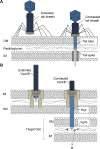The Versatile Type VI Secretion System
- PMID: 27227310
- PMCID: PMC4887148
- DOI: 10.1128/microbiolspec.VMBF-0026-2015
The Versatile Type VI Secretion System
Abstract
Bacterial type VI secretion systems (T6SSs) function as contractile nanomachines to puncture target cells and deliver lethal effectors. In the 10 years since the discovery of the T6SS, much has been learned about the structure and function of this versatile protein secretion apparatus. Most of the conserved protein components that comprise the T6SS apparatus itself have been identified and ascribed specific functions. In addition, numerous effector proteins that are translocated by the T6SS have been identified and characterized. These protein effectors usually represent toxic cargoes that are delivered by the attacker cell to a target cell. Researchers in the field are beginning to better understand the lifestyle or physiology that dictates when bacteria normally express their T6SS. In this article, we consider what is known about the structure and regulation of the T6SS, the numerous classes of antibacterial effector T6SS substrates, and how the action of the T6SS relates to a given lifestyle or behavior in certain bacteria.
Figures





References
Publication types
MeSH terms
Substances
Grants and funding
LinkOut - more resources
Full Text Sources
Other Literature Sources

